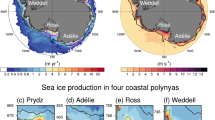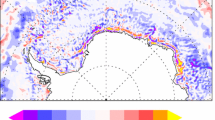Abstract
Coastal polynyas around Antarctica are the place of intense air–sea exchanges which eventually lead to the formation of high-salinity shelf waters (HSSW) over continental shelves. Here, the influence of atmospheric forcing on coastal polynyas in the Ross Sea is studied by contrasting the response of a regional ocean/sea-ice circulation model to two different atmospheric forcing sets. A first forcing (DFS3) is based on ERA40 atmospheric surface variables and satellite products. A second forcing (MAR) is produced on the basis of ERA40 with a dynamical downscaling procedure. As compared to DFS3, MAR forcing is shown to improve substantially the representation of small-scale patterns of coastal winds with stronger katabatic winds along the coast. The response of the ocean/sea-ice model to the two forcing sets shows that the MAR forcing improves substantially the geographical distribution of polynyas in the Ross Sea. With the MAR forcing, the polynya season is also shown to last longer with a greater ice-production rate. As a consequence, a greater flow of dense water out of the polynyas is found with the MAR forcing and the properties of HSSW are notably improved as compared to the DFS3 forcing. The factors contributing to the activity of Terra Nova Bay and Ross Ice Shelf polynyas in the model are studied in detail. The general picture that emerges from our simulations is that the properties of HSSW are mostly set by brine rejection when the polynya season resume. We found that coastal polynyas in the Ross Sea export about 0.4 Sv of HSSW which then flows along three separate channels over the Ross Shelf. A 6-month time lag is observed between the peak of activity of polynyas and the maximum transport across the sills in the channels with a maximum transport of about 1 Sv in February. This lag corresponds to the time it takes to the newly formed HSSW to spread from the polynya to the sills (at a speed of nearly 2 cm s−1).














Similar content being viewed by others
Notes
Note that MAR katabatic winds decrease off-shore whereas DFS3 winds increase. Consequently, the averaged wind speed over the whole area of the TNB polynya is similar in both experiments (Table 2).
References
Arrigo RK, van Dijken GL (2003) Phytoplankton dynamics within 37 Antarctic coastal polynya systems. J Geophys Res. doi:10.1029/2002JC001739
Assmann KM, Hellmer HH, Beckmann A (2003) Seasonal variation in circulation and water mass distribution on the Ross continental shelf. Antarct Sci 15(1):3–11
Barnier B, Madec G, Penduff T, Molines JM, Tréguier AM, Beckmann A, Biastoch A, Boning C, Dengg J, Gulev S, Le Sommer J, Rémy E, Talandier C, Theetten S, Maltrud M, Mc LJ (2006) Impact of partial steps and momentum advection schemes in a global ocean circulation model at eddy permitting resolution. Ocean Dyn 56:543–567
Beckmann A, Dosher R (1997) A method for improved representation of dense water spreading over topography in geopotential-coordinate models. J Phys Oceanogr 27:581–591
Biastoch A, Böning CW, Lutjeharms JRE (2009) Agulhas leakage dynamics affects decadal variability in Atlantic overturning circulation. Nature 456:489–492
Brodeau L, Barnier B, Penduff T, Treguier A-M, Gulev S (2010) An ERA40 based atmospheric forcing for global ocean circulation models. Ocean Model 31:88–104
Broeke MR, Van De Wal RSW, Wild M (1997) Representation of antarctic katabatic winds in a high-resolution GCM and a note on their climate sensitivity. J Climate 10:3111–3130
Bromich DH (1989) Satellite analysis of Antarctic wind behaviour. Bull Am Meteorol Soc 70:738–749
Brun E, David P, Sudul M, Brunot G (1992) A numerical model to simulate snow cover stratigraphy for operational avalanche forecasting. J Glaciol 128:13–22
Budillon G, Pacciaroni M, Cozzy S, Rivaro P, Ianni C, Cantoni C (2003) An optimum multiparameter mixing analysis of shelf waters in the Ross Sea. Antarct Sci 15:105–118
Dinniman MS, Klinck JM, Smith WO Jr (2007) Influence of sea ice cover and icebergs on circulation and water mass formation in a numerical circulation model of the Ross Sea, Antartica. J Geophys Res. doi:10.1029/2006JC004036
Drakkar Group (2007) Eddy-permitting ocean circulation hindcasts of past decades. CLIVAR Exchanges 42:8–10
Fichefet T, Morales Maqueda MA (1997) Sensitivity of a global sea ice model to the treatment of ice thermodynamics and dynamics. J Geophys Res 102(C6):12.609–12.646
Gallée H (1995) Simulation of the mesocyclonic Activity in the Ross Sea, Antarctica. Mon Weather Rev 123:2050–2069
Gallée H, Schayes G (1994) Development of a three dimensional meso-scale primitive equations model, katabatic winds simulation in the area of Terra Nova Bay. Ant Mon Weather Rev 122:671–685
Gallée H, Guyomarc’h G, Brun E (2001) Impact of snow drift on the antarctic ice sheet surface mass balance: possible sensitivity to snow-surface properties. Bound-Layer Meteorol 99:1–19
Gallée H, Peyaud V, Goodwin I (2005) Simulation of the net snow accumulation along the Wilkes Land transect, Antarctica, with a regional climate model. Ann Glaciol 41:1–6
Gordon AL, Huber B, McKee D, Visbeck M (2010) A seasonal cycle in the export of bottom water from the Weddell Sea. Nat Geosci 3(551):556
Hervieux G (2007) Etudes numérique des interactions courant-topographie: applications au gyre subpolaire, aux seuils de gibraltar et des mers Nordiques. phd thesis, Université Joseph Fourier, 2007
Hibler W (1979) A dynamic thermodynamic sea ice model. J Phys Oceanogr 9:815–846
Hoppema M, Anderson LG (2007). Biogeochemistry of polynyas and their role in sequestration of anthropogenic constituents. In: Smith WO Jr et al (eds) Polynyas: windows to the world. Elsevier Oceanography Series 74:193–221
Jacobs SS, Comiso JC (1989) Sea ice and oceanic processes on the Ross Sea continental shelf. J Geophys Res 94(C12):18,195–18,211
Jacobs S, Hellmer H, Doake D, Jenkins A, Frolich R (1992) Melting of ice shelves and the mass balance of Antarctica. J Glaciol 38:375–387
Jourdain NC (2007) Simulations climatiques couplées Atmosphère Océan Glace de mer en Antarctique. PhD Thesis, Université Joseph Fourier. Online: http://tel.archives-ouvertes.fr/tel-00266564/en/
Jourdain NC, Gallée H (2011) Influence of the representation of glacier valleys across the Transantarctic Mountains in an atmospheric regional model. Clim Dyn 36(5–6):1067–1081
Jourdain NC, Mathiot P, Gallée H, Barnier B (2011) Influence of coupling on atmosphere, sea ice and ocean regional models in the Ross Sea sector, Antarctica. Clim Dyn 36(7–8):1523–1543. doi:10.1007/s00382-010-0889-9
Kurtz D, Bromwich DH (1985) A recurring, athmospherically forced polynya in Terra Nova Bay. In: Jacobs SS (ed) Oceanology of the Antarctic Continental Shelf. Antarc Res Series, vol 43. A.G.U., Washington, D. C., pp 177–201
Large WG,Yeager SG (2004) Diurnal to decadal global forcing for ocean and sea-ice models: The data sets and flux climatologies. Technical Report TN-460 + TR, NCAR, p 105
Le Sommer J, Penduff T, Theetten S, Madec G, Barnier B (2009) How momentum advection schemes influence current-topography interactions at eddy permitting resolution. Ocean Model 29(1):1–14
Lübbecke J, Böning CW, Biastoch A (2008) Variability in the subtropical–tropical cells and its effect on near-surface temperature of the equatorial Pacific: a model study. Ocean Sci 4:73–88
Lythe MB, Vaughan DG (2001) BEDMAP: a new ice thickness and subglacial topographic model of Antarctica. J Geophys Res Solid Earth 106:11335–11351
Madec G (2008) NEMO, the Ocean Engine. Tech. rep., Notes de l’IPSL (27), ISSN1288-1619, Université P. et M. Curie, B102 T15-E5, 4 place Jussieu, Paris cedex 5, p 193
Morales Maqueda MA, Willmot AJ, Biggs NRT (2004) Polynya dynamics: a review of observations and modelling. Rev Geophys 42, RG1004, doi:10.1029/2002RG000116
Massom R, Harris PT, Michael KJ, Potter MJ (1998) The distribution and formative processes of latent heat polynyas in East Antarctica. Ann Glaciol 27:420–426
Massonnet F, Fichefet T, Goosse H, Vancoppenolle M, Mathiot P, Koënig Beatty C (2011) On the influence of model physics on simulations of Arctic and Antarctic sea ice. Cryosphere 5(687–699):2011
Mathiot P (2009) Influence du forage atmosphérique sur la représentation de la glace de mer et des eaux de plateau en Antarctique dans une étude de modélisation numérique, Phd thesis, Université Joseph Fourier. Available from: http://tel.archives-ouvertes.fr/tel-00375960
Mathiot P, Barnier B, Gallée G, Molines JM, Le Sommer J, Juza M, Penduff T (2010) Introducing katabatic winds in global ERA40 fields to simulate their impacts on the Southern Ocean and sea-ice. Ocean Model 35(4):277–344
Mathiot P, Goosse H, Fichefet T, Barnier B, Gallée H (2011) Modelling the seasonal variability of the Antarctic slope current. Ocean Sci 7:455–470
Orsi AH, Wiederwohl CL (2009) A recount of Ross Sea waters. Deep-Sea Res II 56:778–795
Orsi AH, Johnson GC, Bullister JL (1999) Circulation, mixing and production of Antarctic bottom water. Prog Oceanogr 43:55–109
Penduff T, Le Sommer J, Barnier B, Treguier A-M, Molines J-M, Madec G (2007) Influence of numerical schemes on current-topography interactions in 1/4° global ocean simulations. Ocean Sci 3:509–524
Penduff T, Juza M, Brodeau L, Smith GC, Barnier B, Molines J-M, Treguier A-M, Madec G (2010) Impact of global ocean model resolution on sea-level variability with emphasis on interannual time scales. Ocean Sci 6:269–284
Petrelli P, Bindoff NL, Bergamasco A (2008) The sea ice dynamics of Terra Nova Bay and Ross Ice Shelf Polynyas during a spring and winter simulation. J Geophys Res 113(C09). doi:10.1029/2006JC004048
Smith WHF, Sandwell DT (1997) Global sea-floor topography from satellite altimetry and ship depth soundings. Science 277:1956–1962
Tamura T, Ohshima KI, Nihashi S (2008) Mapping of sea ice production for Antarctic coastal polynyas. Geophys Res Lett. doi:10.1029/2007GL032903
Timmermann R, Goosse H, Madec G, Fichefet T, Ethe C, Dulière V (2005) On the representation of high latitude processes in the ORCA-LIM global coupled sea ice-ocean model. Ocean Model 8:175–201
Treguier A-M, Barnier B, de Miranda A, Molines J-M, Grima N, Imbard M, Madec G, Messager C, Michel S (2001) An eddy permitting model of the Atlantic circulation: evaluating open boundary conditions. J Geophys Res 106:22115–11129
Tremblay JE, Smith WO (2007) Primary production and nutrient dynamics in polynyas. In: Barber DG, Smith WO (eds) Polynyas: windows into the world. Elsevier, New York, pp 239–270
Williams GD, Bindoff NL, Marsland SJ, Rintoul SR (2008) Formation and export of dense water from the Adélie Depression, East Antarctica. J Geophys Res 113(C04)
Acknowledgments
The authors acknowledge support from Ministère de l’Education Nationale et de la Recherche and from Centre National de la Recherche Scientifique (CNRS). This work is a contribution of the DRAKKAR project. Support to DRAKKAR comes from various grants and programmes listed hereafter: French national programmes GMMC, LEFE, and PICS2475. The contribution of Institut National des Sciences de l’Univers (INSU) to these programmes is particularly acknowledged. DRAKKAR acknowledge the support from the Centre National d’Etudes Spatiales (CNES) through the OST/ST. Computations presented in this study were performed at Institut du Développement et des Ressources en Informatique Scientifique (IDRIS) and on the local MIRAGE computer. Partial support from the European Commission under Contract SIP3-CT-2003-502885 (MERSEA project) is gratefully acknowledged. The authors are also grateful to the members of the Drakkar Group for their lively discussions and comments during the annual DRAKKAR meeting. Josiane Brasseur is thanked for her continuous support.
Author information
Authors and Affiliations
Corresponding author
Additional information
Responsible Editor: Pierre De Mey
Rights and permissions
About this article
Cite this article
Mathiot, P., Jourdain, N.C., Barnier, B. et al. Sensitivity of coastal polynyas and high-salinity shelf water production in the Ross Sea, Antarctica, to the atmospheric forcing. Ocean Dynamics 62, 701–723 (2012). https://doi.org/10.1007/s10236-012-0531-y
Received:
Accepted:
Published:
Issue Date:
DOI: https://doi.org/10.1007/s10236-012-0531-y




